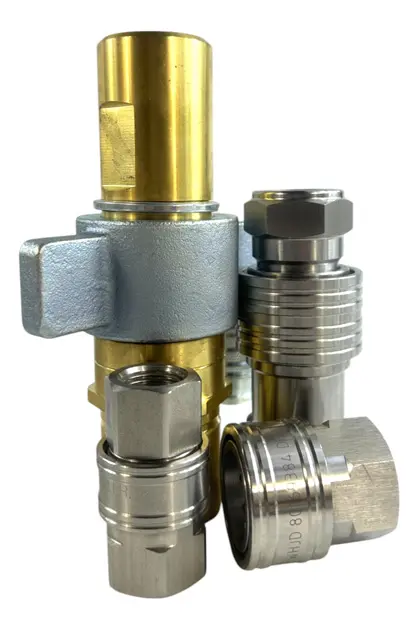You might hear someone refer to a “3/4 inch JIC” fitting, only to see the specifications list a 1-1/16 inch thread. At first glance, it sounds like a mismatch—but they’re actually talking about the same fitting. So what’s going on?
You’re not alone! This is one of the most common points of confusion with JIC (Joint Industry Council) fittings. Let’s break it down to make sure you get the right part every time.
What is a JIC Fitting?
First, a quick refresher. JIC fittings are a very common type of hydraulic connector. They are known for their 37-degree flare sealing surface. When you connect a male and female JIC fitting, the flared end of the male piece seals tightly against the conical seat of the female piece, creating a reliable, leak-free connection for medium to high-pressure hydraulic systems.
The Sizing Puzzle: Tube Size vs. Thread Size
Here’s where the confusion often starts. JIC fittings are typically referenced in two ways:
- By the Nominal Tube Size: This is the outside diameter (OD) of the hydraulic tubing that the fitting is designed to connect to. This is usually given in fractional inches (like 1/4″, 1/2″, 3/4″, 1″). When someone says “3/4 inch JIC,” they are referring to a fitting designed for 3/4″ OD tubing.
- By the Actual Thread Size: JIC fittings use UNF (Unified Fine) or UNJ (Unified National Special) threads. This is the physical measurement of the threads themselves (diameter and threads per inch).
The Key Relationship: How Tube Size Relates to Thread Size
The crucial thing to understand is that a specific nominal tube size corresponds to a specific, different actual thread size. They aren’t the same number!
Here are some common JIC tube sizes and their corresponding thread sizes:
| JIC Fitting | Tube OD | Actual Thread Size |
|---|---|---|
| 1/4″ JIC | 1/4″ | 7/16″-20 UNF |
| 3/8″ JIC | 3/8″ | 9/16″-18 UNF |
| 1/2″ JIC | 1/2″ | 3/4″-16 UNF |
| 3/4″ JIC | 3/4″ | 1-1/16″-12 UNJ/UNF |
| 1″ JIC | 1″ | 1-5/16″-12 UNJ/UNF |
| 1-1/4″ JIC | 1-1/4″ | 1-5/8″-12 UNJ/UNF |
Do you see it now?
When you see “3/4″ JIC,” it refers to the system size or the tube it fits. The fitting itself will have a larger, actual thread size of 1-1/16 inches. The AN/JIC sizing charts often show this clearly, listing the Dash Size (-12 for 3/4″), the Tube OD (3/4″), and the Thread Size (1-1/16″-12).
Why the Two Numbers?
Referring to fittings by tube size is practical because it relates directly to the hydraulic line size you are working with and the flow capacity of the system. However, the actual thread size is essential for physically identifying and mating the correct male and female fittings.
How to Avoid Ordering the Wrong Part
Knowing this relationship is key! When ordering or replacing JIC fittings:
- Always try to confirm both: If possible, look for the tube size and the thread size in the equipment manual, on the hose assembly tag, or by carefully measuring the existing fitting.
- Measure Carefully: If measuring an existing fitting, use a caliper to determine the thread OD and a thread gauge to count the threads per inch.
- Consult a Chart: Keep a JIC size chart handy (like the one above) to cross-reference tube size and thread size.
- When in Doubt, Ask! Don’t guess. Provide your supplier with as much information as possible (equipment make/model, photo of the fitting, measurements).
In Conclusion
The confusion between JIC tube size (like 3/4″) and thread size (like 1-1/16″) is common, but easily understood once you know the relationship. Remember that the tube size refers to the tubing the fitting is used with, while the thread size is the actual dimension for mating.
By understanding this, you can confidently identify and order the correct JIC fittings for your hydraulic system needs.
Still unsure about a specific fitting? Contact our parts specialists! We’re here to help you find exactly what you need.
